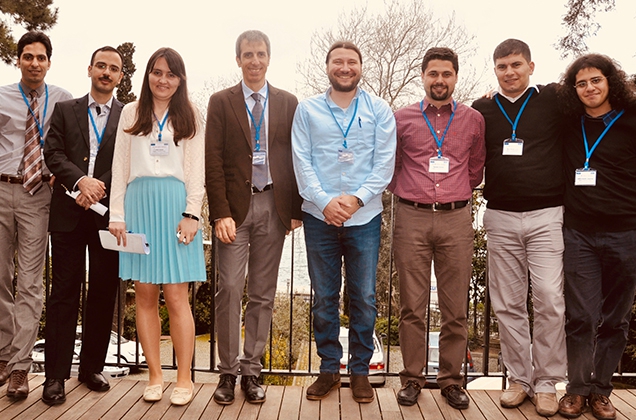13/08/2018
A research team led by Sabancı University Faculty of Engineering and Natural Sciences Member İsmet İnönü Kaya developed a graphene-based screen prototype as part of the "ELMAS Project". Their work to develop a Graphene-Based OLED Screen produced the highest pixel resolution in any graphene-based screen so far.

PHOTO: left to right: Vahid Sazgari Ardakani, Mohammad Hadi Khaksaran, Sibel Kasap, İsmet İnönü Kaya, Cenk Yanık , Hasan Özkaya, Süleyman Çelik, Abdülkadir Canatar
Researchers of the "ELMAS Project" ongoing at the Sabancı University Nanotechnology Research and Application Lab (SUNUM) in partnership with ASELSAN achieved a breakthrough success. The prototypes developed by the researchers have the highest pixel resolution in any graphene-based screen so far.
The technology allows for designing miniature as well as large-area screens in custom sizes for the defense industry to be used in thermal vision and avionic applications.
The project also involves developing and building prototype screen modules based on reinforcing LCD screens that are being used in military cockpits and are subject to export licensing.

ASELSAN and the Sabancı University Nanotechnology Research and Application Center (SUNUM) built Turkey's first facilities for developing OLED screens and graphene synthesis technologies.
The research team is led by Sabancı University Faculty of Engineering and Natural Sciences Member İsmet İnönü Kaya. Lead researchers are project engineers Süleyman Çelik, Hasan Özkaya and Dr. Sibel Kasap, and researchers are Sabancı University students Cenk Yanık (PhD graduate), Hadi Khaksaran (PhD), Vahid Ardakan (PhD), and Abdülkadir Canatar (BA and MSc).
The positive outcomes of the Graphene-Based OLED Screen Development efforts led by ASELSAN and Sabancı University were presented by Sabancı University Associate Professor İsmet Kaya at the Eurodisplay Conference in Berlin. Conference participants were keenly interested in the presentation, and the event committee considered the work to have "potential for high impact."
The work received a publication offer from the Journal of the Society for Information Display.
The prototypes developed by the researchers made history as the highest pixel resolution in any graphene-based screen so far.

Use in flexible screens and wearable technologies
The ELMAS Project uses graphene instead of indium tin oxide (ITO), which is the default material for anodes in OLED screens. Graphene is expected to play a key part in flexible screens and wearable technologies in the future.
Being a carbon crystal that is only one atom thick, graphene is suited to application in many technologies with its translucency, high electrical conductivity, resilience and flexibility.
Discovered in 2004, graphene won its discoverers the 2010 Nobel Prize in Physics.
Transparent, flexible, light and portable graphene-based screens are expected to mostly replace current solutions in military and civilian applications.





